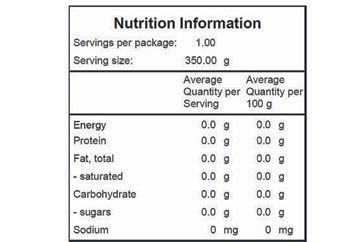Understanding the Nutrition Information Panel: A Parent’s Guide
Hey there, super parents! Are you always on the lookout for what’s best for your kiddos? Then you’re in the right place! Today, we’re diving into the world of Nutrition Information Panels (NIPs). These handy tables are your secret weapon to making informed choices about the food you bring home to your family table. So, let’s get the scoop on how to read these labels like a pro!
Whether you’re out shopping for the week’s groceries or planning the next family meal, knowing how to decipher a Nutrition Information Panel can be your gateway to a healthier diet for your whole family. It’s not just about counting calories; it’s about understanding what those numbers and percentages really mean for your little ones’ growth and development. Let’s break it down together, shall we?
Why Nutrition Information Panels Matter
Before we dive into the nitty-gritty, why should you even bother with NIPs? Well, beyond just the legal requirement, these panels give you the lowdown on what’s actually in the food your family eats. From vitamins and minerals to sugar, fats, and proteins, this information is crucial for parents who want to make well-informed decisions catered to their family’s health needs. Allergies? Dietary restrictions? NIPs have got you covered!
The Key Elements of a Nutrition Information Panel
Serving Size and Servings Per Package
First things first, find out what the serving size is. This is the amount of food that the nutrition info is based on. Now, it might not match how much your family actually eats in one sitting, but it’s a starting point. Pay attention to the servings per package too—this tells you how many of those servings are in the entire container. Bigger family? Then you’ll need to multiply the numbers to meet your needs!
Calories Per Serving
Energy, energy, energy! Calories give your kids the fuel they need to run, play, and learn. But it’s all a balancing act; too few, and they won’t have enough oomph, too many, and they might not use it all. Knowing the calorie content per serving helps you plan meals that keep your family’s energy levels just right.
Nutrients: Fats, Carbohydrates, Proteins, and More
Nutrients are your body’s building blocks. Fats, for instance, are crucial for brain health, but not all fats are created equal. Unsaturated fats? Thumbs up! Saturated and Trans fats? Limit those. Carbohydrates are the body’s main fuel source, and fibers, which are a type of carb, help keep your digestive system on track. As for proteins, they’re vital for growing muscles, so definitely keep an eye on those for your active little ones!
Vitamins and Minerals
Vitamins and minerals are like your family’s nutrition superheroes. They support everything from bone health to your immune system. While Vitamin A sharpens eyesight during those book-reading sessions, calcium and Vitamin D ensure strong bones for all the hopscotch and soccer playing. Iron, on the other hand, keeps your kids’ energy and focus at top levels.
We’ve only scratched the surface here, lovelies, but stick with me! We’re about to delve deeper into each of these sections, understand Daily Values (DVs), and uncover how to strike that perfect balance of nutrients. By the end of this guide, you’ll be a Nutrition Information Panel whiz, ready to conquer the grocery store aisles and fill your cart with the best choices for your amazing family!
Next up, we’ll discover how to compare products and make sense of those percentages you see on the label. This nutrition detective work is about to get even more interesting, so buckle up! Understanding these labels will help ensure that what you’re putting on the dinner table is not only delicious but nutritious as well. And remember, every little step in learning about what goes into your family’s bodies is a huge leap towards keeping them healthy and happy. Stay tuned for more!

5 Things Parents Should Know Before Preparing for the Nutrition Information Panel
1. Start with the Basics: Understanding the Terminology
Begin by familiarizing yourself with the terms commonly used on Nutrition Information Panels. Knowing the difference between dietary fiber and soluble fiber, or the significance of ‘added sugars’ versus ‘total sugars,’ is essential. Being able to identify key nutritional terms will empower you to better interpret the data on the panel.
2. Consider Your Child’s Nutritional Needs
Every child is unique, and their nutritional requirements vary based on age, activity level, and health status. For instance, children involved in sports may need more protein and carbohydrates for energy and recovery. Understanding your child’s specific needs will guide you to focus on certain aspects of the NIP, like the amounts of iron, calcium, or vitamins.
3. Know the Significance of % Daily Values
The % Daily Values (%DV) on a Nutrition Information Panel are based on the daily intake levels recommended for the average adult. These may not be perfectly suited for children since their needs differ. Nevertheless, they offer a rough guide to determine if a food item is high or low in a specific nutrient. As a rule of thumb, 5% DV or less is low, and 20% DV or more is high.
4. Deciphering the Ingredients List
Alongside the Nutrition Information Panel, the ingredients list is a valuable resource. It’s ordered by quantity, from the highest to the lowest. This helps you identify the main components of the product and be on the lookout for any items that you might want to minimize in your child’s diet, such as added sugars, salt, and certain fats.
5. Understanding Portion Sizes Versus Family Portions
The serving sizes listed on NIPs may not reflect the quantity your child eats. It’s crucial to adjust the nutritional information based on the actual portion your child consumes. If the serving size is one cup and your child eats two, you’ll need to double the nutritional values to get an accurate picture of their intake.
Equipping yourself with this knowledge about Nutrition Information Panels before you set foot in the supermarket will transform the way you shop and plan your family’s meals. With these insights, you’ll be ready to sift through marketing claims and choose foods that truly contribute to your children’s well-being. It’s not just about picking a food item off the shelf; it’s about making each calorie count and ensuring those little bodies get the right types of fuel to thrive. So, dear parents, embrace your new role as the ultimate nutrition sleuths for your family!
See more great Things to Do with Kids in New Zealand here. For more information see here
Disclaimer
The articles available via our website provide general information only and we strongly urge readers to exercise caution and conduct their own thorough research and fact-checking. The information presented should not be taken as absolute truth, and, to the maximum extent permitted by law, we will not be held liable for any inaccuracies or errors in the content. It is essential for individuals to independently verify and validate the information before making any decisions or taking any actions based on the articles.




